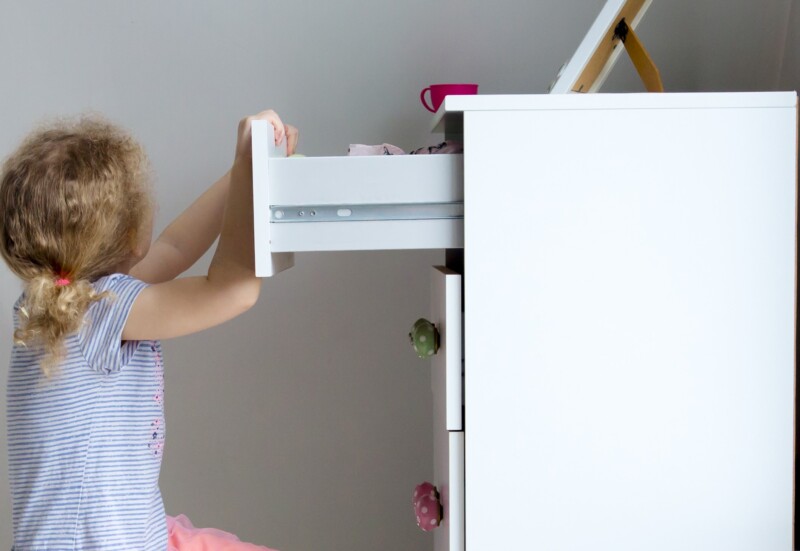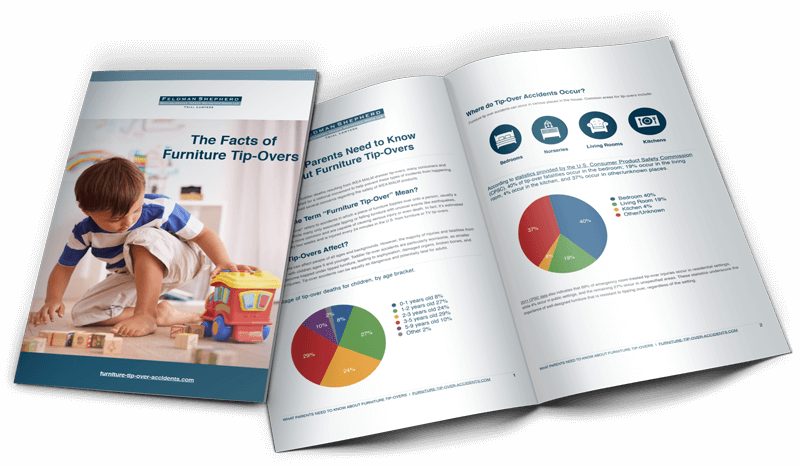STURDY Act Awaits Final Vote by U.S. House
In a hard-earned victory for child safety advocates, a new mandatory federal safety standard that will save young children from injuries and deaths associated with dresser tip-overs was published in the Federal Register on November 25, 2022.
The Safety Standard for Clothing Storage Units was approved in a 3-1 vote by the Consumer Product Safety Commission (CPSC) on October 19, 2022. It takes effect 180 days after publication in the Federal Register, and the clock is now ticking. Parents who have lost children to dresser tip-overs — including several former Feldman Shepherd clients whose children died from IKEA dresser tip-overs — advocated for years to get this new rule passed. These brave parents are also close to getting a national law passed that most certainly would prevent dresser tip-overs and keep children safe in their own bedrooms.
From January 2000 through April 2022 there were 234 reported fatalities from dressers (referred to in the furniture industry as “clothing storage units”) tipping over, including 199 child fatalities, according to the CPSC. The CPSC estimates that there were 84,100 dresser tip-over-related injuries (an estimated annual average of 5,300 injuries) treated in U.S. hospital emergency departments from 2006 through 2021. Of these, an estimated 72 percent were injuries to children. From January 2000 through July 2022, there have been 43 recalls in response to dresser tip-over hazards, involving more than 21 million dressers.
Unstable dressers are particularly risky for curious toddlers, as starting at about age 2 they may open multiple dresser drawers or attempt to climb or sit in a drawer. Unfortunately, young children do not have the strength to prevent a dresser from falling or to lift a dresser that has tipped over onto them. Making an already dangerous situation worse, tip-over accidents often occur when parents think their child is safely asleep in bed, and parents may not hear the dresser fall because the child’s body and carpet often cushions the impact. And for every tip-over that causes injury, there are hundreds of “near misses” where a toddler manages to get out of the way, or a nearby adult catches the dresser, or it falls onto a bed or other nearby object.
Yet, up until now, the stability of dressers has been governed by nothing more than a voluntary safety standard created primarily by the furniture industry itself.
While manufacturers (and some members of the public) argue that dresser tip-overs could easily be prevented if consumers would simply anchor their furniture to a wall, this argument ignores real-world considerations. For instance, many people do not own or know how to use power tools and are not comfortable with drilling holes into their walls and furniture. Also, many families are not permitted to make holes in the walls of rented apartments, or they may have baseboard heating which prevents a dresser from being positioned flush against the wall. A Consumer Reports investigation in 2018 found that only 27 percent of Americans have anchored furniture in their homes. Anchors clearly are not a substitute for high-quality, safe design of dressers that are stable and tip-resistant.
What Does the New Federal Safety Rule for Dressers Require?
The new safety rule provides that dressers which are 27 inches tall or over, and that fall within certain other criteria, are required to meet minimum stability requirements. The stability requirements reflect real-world conditions, like multiple open drawers, drawers containing clothing, dressers placed on carpet, and the forces a child exerts while climbing or pulling on a dresser.
The standard also sets forth requirements for testing the stability of dressers, including those with interlocks. Interlocks can improve dresser stability by preventing more than one drawer from being opened at the same time. In addition to the stability requirements, the new standard requires that dressers be marked and labeled with safety and identification information and display a hang tag providing performance and technical data about the product’s stability.
The standard has been met with resistance by major players in the U.S. residential furniture industry. On December 6, 2022, the American Home Furnishings Alliance, a trade association which represents more than 200 of the industry’s leading manufacturers and importers, filed a petition in the U.S. Court of Appeals for the Fifth Circuit seeking to have the rule vacated. The Mississippi Manufacturers Association and Mississippi Economic Council joined in the petition.
These industry groups maintain that: the complexity of the performance testing requirements in the CPSC rule will make it unenforceable; compliance costs that are not reflected in the rule’s cost/benefit analysis will make compliant furniture cost-prohibitive for many American families; and stability testing should provide consumers with an assurance of compliance, rather than a sliding-scale stability rating provided for in the rule.
A Legislative Solution
The CPSC standard was approved three weeks after the U.S. Senate passed an amended version of the STURDY ACT (Stop Tip-Overs of Unstable, Risky Dressers on Youth Act), bringing mandatory stability requirements for dressers one step closer to becoming law. The U.S. House of Representatives passed the STURDY Act in June 2021, and the legislation amended by the Senate must go back to the House for a final vote.
This is the third attempt by lawmakers in recent years to strengthen the safety standard. Similar bills introduced in the 115th and 116th Congresses did not make it to the finish line. Again, parents who have lost children to dresser tip-over tragedies have fought mightily for this legislative solution.
In addition to the support of these parents, the STURDY Act also has received an unprecedented level of support and collaboration from a broad group of stakeholders, including consumer advocates, the furniture and retail industries, and child-safety experts. Parents Against Tip-Overs, whose founders include two former Feldman Shepherd clients, and the American Home Furnishings Alliance both have urged the House to pass the STURDY Act immediately and send it to President Biden to be signed into law.
Preventing Future Tragedies
Every day at Feldman Shepherd, we are inspired by so many of our clients who dedicate themselves to a mission to prevent other families from suffering tragedies similar to their own. We extend our gratitude and appreciation to all our furniture tip-over clients who have tirelessly advocated to help keep children safe in their bedrooms.
As the clock ticks down on the final days of the 117th Congress, the window of opportunity for lawmakers to pass this lifesaving legislation will soon come to a close. We encourage you to contact your congressperson and let them know that you support immediate passage of the STURDY Act. With children’s lives at stake, we must get this done.
For a list of U.S. representatives’ contact information, CLICK HERE.


